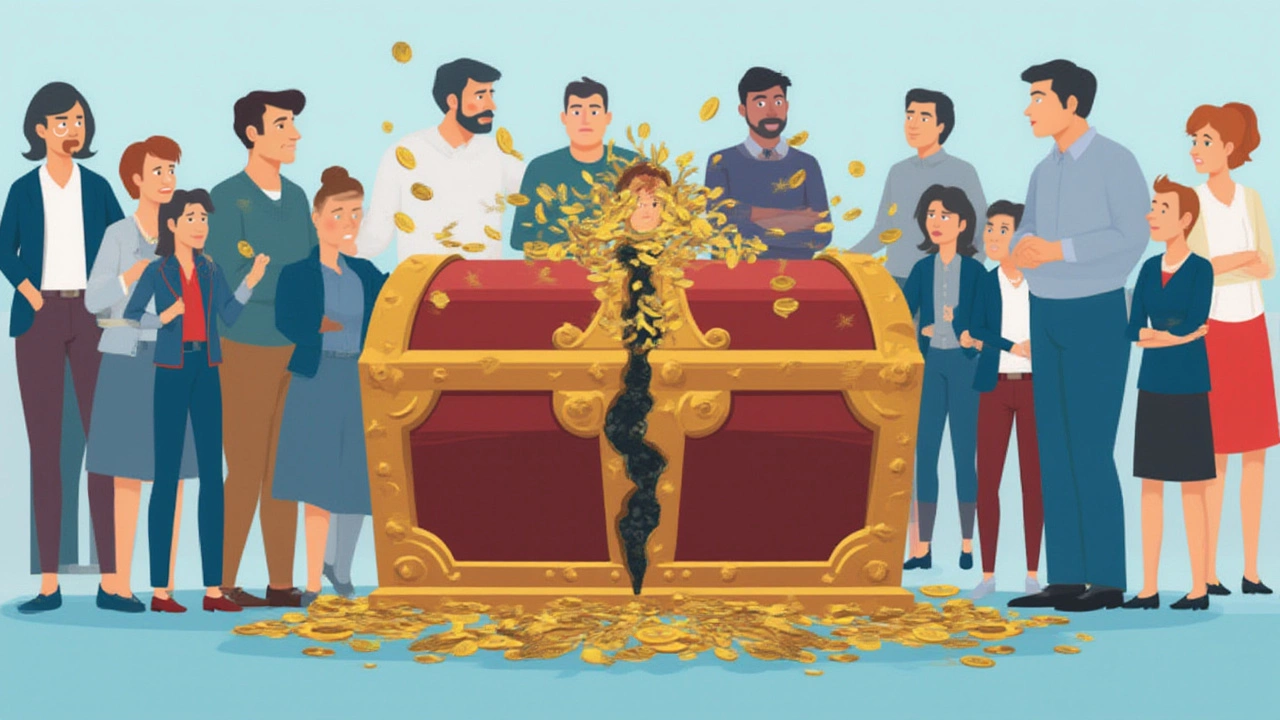Picture this: you work hard for decades, thinking your pension will handle retirement. But behind that comforting idea, there’s a side not everyone talks about—pensions aren’t foolproof. In fact, relying too heavily on them can trip you up. Changes in the job market, people living longer than ever, and unpredictable economic storms mean your pension isn’t always the rock-solid plan it used to be. If you ever wondered why some retirees feel caught off guard, keep reading. Let’s break down the key disadvantage of a pension and what you can do to keep your retirement dreams on track.
Lack of Flexibility: Why Pensions Can Tie Your Hands
The biggest sticking point for most pensions is their lack of flexibility. Most traditional pensions, especially defined benefit schemes, decide for you when and how you’ll get your money. If you want to retire early or withdraw a chunk for a family emergency, you’re often at the mercy of the rules. Once you start taking your pension, that’s it—you get regular payments, usually not adjustable. Want to buy a property, start a business, or help a loved one? The money’s essentially locked up. With workplace pensions, you generally have to wait until a certain ‘pensionable age,’ typically in your late 50s or 60s, before you can touch your savings.
Now, some modern pension schemes, like defined contribution plans, try to offer more options, but even then, you need to navigate complex rules and potential penalties for drawing down funds early. It’s not like a regular savings account where you can dip in and out. If you value having control over your own money, this rigidity can be a major turn-off. And if laws change—say, the government raises the minimum pension age—you might have no choice but to play along.
Let’s not forget about moving jobs. In today’s gig economy, people switch careers more than ever. That means you could collect several small pensions over time, each with its own withdrawal rules, age limits, and transfer headaches. Want to combine them? Again, expect paperwork, possible fees, and sometimes the risk of losing precious benefits. If freedom and adaptation are priorities for you in retirement planning, traditional pensions just aren’t built for that kind of agility.
This rigidity becomes painfully obvious if your plans or health change suddenly. Waiting to access your pension when you need money most can be frustrating, especially if life throws you an expensive curveball. That’s why so many advisers tell their clients to think about more flexible retirement products or to supplement their pensions with ISAs or investment accounts. You're trading a bit of security for a lot more control over your money.
Market and Funding Risks: Not as Safe as They Seem
Even the word “pension” feels safe—the very opposite of risky stocks or crypto. But here’s the kicker: pensions do have real risks under the hood. Defined benefit pensions (the old-school kind you might get from a government role or a big corporation) rely heavily on their employers investing smartly and staying afloat. If the company hits trouble or goes bankrupt—think of high-profile cases like Carillion in the UK or some American steelmakers—suddenly those promised retirements come under threat.
Take a look at the numbers. In the UK, about 5,000 ‘final salary’ pension schemes are in deficit, with shortfalls totalling over £200 billion as of 2024. That means there simply isn’t enough money to pay every promised pension at the full rate. US public pension systems aren’t immune either; Illinois’ state pension system, for example, has one of the world’s largest unfunded liabilities, surpassing $140 billion in 2023.
Even if you’re in a defined contribution pension (where your employer and you put in money and the savings are invested), you’re not off the hook. The value of your pot swings up and down with the markets. If there’s a global downturn—like during COVID or the 2008 crisis—your retirement savings can shrink right before you need them. There’s no cast-iron guarantee you’ll get the amount you expect, especially if you have to retire in a bad year for the stock market.
Pension protection schemes exist, sure, but they often don’t cover 100% of what you were promised. For example, the UK’s Pension Protection Fund typically pays out 90% of your pension if your employer collapses, which sounds fine until you realise you could lose thousands a year. In the US, the Pension Benefit Guaranty Corporation (PBGC) places strict limits on payouts if your plan fails.
People sometimes assume their money is ‘safe’ because it's ringfenced, but trustees may have to make tough decisions if the fund faces a shortfall—sometimes cutting benefits, freezing payments, or even increasing your contributions. It’s a bit of a lottery and something most people don’t consider when signing up to a pension.

Inflation’s Silent Attack: How Rising Prices Shrink Pension Value
If you’ve ever noticed prices creeping up at the supermarket, you get why inflation is a killer for retirement income. Here’s the scary part: many pensions aren’t designed to keep up with the true cost of living over decades. Let's say your company offers £10,000 a year through your pension. It feels decent today, but if inflation ticks along at 3% a year, that same payout will buy you less bread, fuel, and medicine in ten or twenty years.
Only some defined benefit schemes offer robust inflation protection, and most are capped. UK schemes, for example, usually have a maximum annual rise (typically 2.5% or 5%). If inflation spikes, like it did after the global energy shocks in 2022 and 2023, your increase won’t match reality. Private and defined contribution plans almost never provide guaranteed inflation-proof income—you’re left to juggle investment returns, annuities, and withdrawals to keep up.
Take a look at this simple table showing the effect of inflation over time on a £10,000 pension:
| Year | Pension Value (£) | Price Equivalent (2025 £) |
|---|---|---|
| 2025 | £10,000 | £10,000 |
| 2030 | £10,000 | £8,626 |
| 2040 | £10,000 | £6,627 |
| 2050 | £10,000 | £5,090 |
These figures use 3% annual inflation for illustration—over 25 years, your spending power is halved. Pretty sobering, right? Unless you plan ahead, you risk getting squeezed as years pass.
What can you do? Some people take a blended approach. Instead of relying just on pension income, they keep some money in flexible investments—think stocks, diversified funds, rental properties—so they can top up their retirement pay if prices jump faster than expected. Others look for index-linked annuities, though those can be costly and aren’t available everywhere. The main point: if you lean only on a pension, inflation can quietly erode your comfort and security.
Inheritance and Death Benefits: Pensions Aren’t Always for the Next Generation
Lots of folks dream of leaving a legacy—helping kids, partners, or charities when they’re gone. Pensions can make that tough. Unlike a house or savings account, traditional pensions often stop or reduce benefits when you die. If you’re lucky, your spouse might get part of your pension, but many schemes cut this by half or more. With some older-style defined benefit pensions, payments just stop at death. That’s a hard pill to swallow when you’ve spent years building up your nest egg.
Defined contribution pensions have more flexibility, but it’s not always simple. You typically need to nominate a beneficiary, and even then, rules—or taxes—can get in the way. In the UK, if you die after age 75, your heirs may face income tax on whatever they inherit from your pension. In the US, there are ‘required minimum distribution’ rules that force heirs to take money out, often raising their own tax bills and limiting how long they can benefit from your savings.
Here’s a quick look at different pension types and what usually happens upon death:
| Pension Type | Death Benefit |
|---|---|
| Defined Benefit | Spouse/partner may get 50% or less; often no benefit for children |
| Defined Contribution | Can leave to anyone, but possible taxes for beneficiaries |
| State Pensions (UK/US) | Payments usually stop, sometimes short-term support for spouse |
If leaving money to loved ones matters to you, you’ll want to think creatively—perhaps blending your pension with a life insurance policy or regular investment account, where you have more say over who gets what and when.
Leaving a meaningful legacy isn’t just a financial issue; it’s deeply personal. No one wants a surprise tax bill or to discover their children are entitled to little or nothing. Look over your pension paperwork, update your beneficiaries, and talk with a professional if needed—the rules and tax codes change, and being proactive can make a world of difference.

Tips to Protect Yourself: What You Can Do Better
So, what’s the answer—ditch pensions entirely? Not at all. They’re still one of the most tax-efficient ways to save for retirement, especially if you get free money through employer contributions or government bonuses. The trick is not to fall into the “set and forget” trap. Start by understanding the specific rules of your pension—when can you access it, how much will you actually get, and what are the survivor benefits? If the paperwork or online dashboard makes you want to cry, don’t be embarrassed—most people feel the same. Call your provider or get help from an adviser. Your future self will thank you.
Diversifying is your best friend. Add a flexible ISA, invest in stocks, or consider property—something you can easily access or pass down to the next generation. Don’t just look at what you’ll get today; ask yourself, will my income from this pension keep up if inflation spikes or if I need to boost my withdrawals one year?
Keep an eye on news about your employer, especially if you’re in a defined benefit scheme. If their financial health is shaky, assess your risk—sometimes it’s better to transfer your pension elsewhere, but only after considering all the pros and cons. Also, make sure you review your nominated beneficiaries every year. Big life changes like marriage, divorce, or new children can affect how your pension is paid after your death.
If you’re nearing retirement, find out about drawdown options, annuities, or lump-sum takings. They all have pros and cons, and the rules can change with each budget announcement. Most importantly, don’t be afraid to ask awkward questions. Government websites, charities like Age UK, or regulated financial advisers can help you cut through the jargon.
Thinking about retiring abroad? Check whether your pension lets you do that easily—you’d be surprised how many plans have restrictions or tax headaches attached to overseas withdrawals.
Here’s a handy list to stay on top of your pension:
- Request an annual statement and know your “expected pot” at retirement age
- Check if your plan has built-in inflation protection or survivor’s benefits
- Consider setting up additional savings (ISAs, stocks, or savings accounts)
- Review your pension paperwork each year
- Get help if you’re unsure—don’t let confusion cost you
Pensions are a powerful tool, but they come with rules, quirks, and—yes—drawbacks. Knowing about the pension disadvantages puts you in the driving seat so your best years are really your best. Don’t settle for surprises; make your pension work for you, not the other way around.
